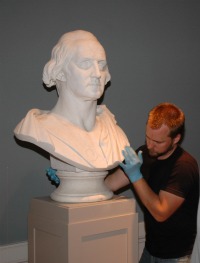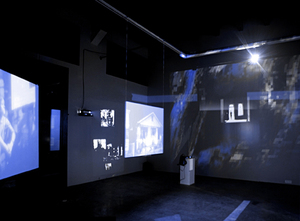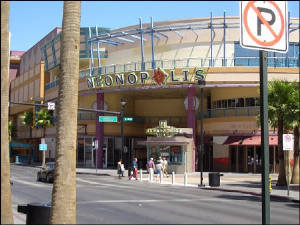This is a shaggy dog story that I should save for the Fourth of July weekend, but…
It’s about a larger-than-life bust of George Washington that may or may not have graced the West Front of the Capitol building in Washington, D.C., but which is indubitably on display now at the Huntington Library, Art Collections and Garden in Pasadena. Oh yes, and it survived a fire and was a gift from France, rather like the Statue of Liberty.
 Here’s the story in brief, which new research/writing by Catherine Hess, chief curator of European art, and John Griswold, an independent conservator, support:
Here’s the story in brief, which new research/writing by Catherine Hess, chief curator of European art, and John Griswold, an independent conservator, support:
The sculpture, by French artist Pierre-Jean David, called David d’Angers (1788-1856), and dated 1832, was commissioned by the French government as a gift to the United States. It was, documents show, on display in the Library of Congress and then on the Capitol building when a fire broke out there in 1851.
“Blackened and pitted,” the bust was thought to be ruined beyond repair and discarded. It then reportedly made its way to someone’s backyard and in 1914 was sold as “scrap marble.” (Who knew?)
Later, the work piece purchased by a New York art dealer, and in 1918, an article in Art and Archeology magazine argued that it was the piece that once adorned the Capitol. Henry E. Huntington must have believed that story, because he bought the bust in 1924 — but kept it in storage, perhaps because The New York Times and other publications criticized the sale of a rediscovered national treasure to a private collector. The U.S. attorney general also made headlines for raising “a question as to the authenticity” of the work, according to the Huntington.
Are you still with me?
Griswold determined that the piece was soiled and stained “possibly with soot,” that chips that might have “popped” off; and that a fine crack across the top of the head may have been the result of high heat exposure from a fire.
Bingo! There was scientific evidence to support early reports that had never been conclusively proved.
So now, the Huntington has pulled the piece out of storage, and on Thursday it went on view.
David d’Angers, btw, believed his bust was, indeed, in the fire. “I read yesterday in an American newspaper of the burning of the Library in Washington; the colossal bust that I sent to America is burnt up,” he wrote. Plus, in 1904, French officials presented the United States with a bronze copy of the bust as a replacement. The bronze is presently displayed in an entryway to the House Chamber at the Capitol.
Photo Credit: Courtesy of the Huntington


 The museum, withe 22,000 sq ft of gallery space, has since 2008 been located on the second floor of the Neonopolis (left). Originally, it was in Henderson, NV — about 15 miles away.
The museum, withe 22,000 sq ft of gallery space, has since 2008 been located on the second floor of the Neonopolis (left). Originally, it was in Henderson, NV — about 15 miles away. 
 I was going to let pass last week’s
I was going to let pass last week’s